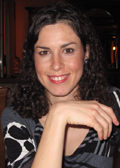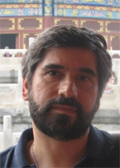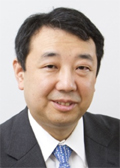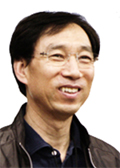Plenary Talks
- Plenary Talk I: August 21, 9:00-10:00, Place: Kyo3-145
The possible future revision of the International System of Units, the SI
Dr. Estefanía de Mirandés and Dr. Alain Picard (Bureau International des Poids et Mesures)
- Plenary Talk II: August 22, 9:00-10:00, Place: Kyo3-145
CONTROL AND OPTIMIZATION IN CYBERPHYSICAL SYSTEMS: FROM SENSOR NETWORKS TO “SMART PARKING” APPS
Dr. Christos G. Cassandras (Boston University)
- Plenary Talk III: August 22, 15:00-16:00, Place: Kyo3-145
Robot & Remote-Controlled Machine Technology for Response of Disasters and Accidents of Nuclear Power Plants
Dr. Hajime Asama (University of Tokyo)
- Plenary Talk IV: August 23, 9:00-10:00, Place: Kyo3-145
Robust 3-D Vision Techniques: Algorithms and Applications
Dr. In So Kweon (KAIST)
The possible future revision of the International System of Units, the SI

Dr. Estefanía de Mirandés
Dr. Estefanía de Mirandés and Dr. Alain Picard
Bureau International des Poids et Mesures, France
Abstract:
The International Bureau of Weights and Measures (BIPM) and National Metrology Institutes (NMIs) have spent many years advancing and improving the International System of Units (SI) by extending the frontiers of metrology to allow a definition of the SI base units in terms of invariants of nature - the fundamental physical constants h, e, k and NA for the definition of the kilogram, ampere, kelvin and mole, respectively.
The numerical values of the fundamental constants h, e, k and NA and their associated uncertainties will be established by CODATA using a sophisticated method to minimize the uncertainty of these values while ensuring consistency among the recommended values for all physical constants.
If the results of experiments are satisfactory and the needs of users are met, formal proposals for changes in the definitions of the kilogram, ampere, kelvin and mole can be presented to a future General Conference on Weights and Measures (CGPM).
The lecture will present the possible future revision of the SI, the current status of determination of the Planck, Avogadro and Boltzmann constants, the criteria for acceptance of the new definitions and the consequences for users when the ‘New SI’ is adopted at a future meeting of the CGPM.
Biography:
Estefanía de Mirandés was born in Spain, in 1980. She received the degree in physics from the Autonomous University of Barcelona, Spain, in 2002 and the Ph.D. degree in physics from the University of Florence, Florence, Italy, in 2006.
In 2006, she joined Laboratoire Kastler Brossel, University of Paris VI, Paris, France, where she worked on the precise determination of the fine structure constant. In 2008, she joined the Bureau International des Poids et Mesures, Sèvres, France, working on the BIPM watt balance.
Since 2010 she has joined the BIPM Mass Department as principal physicist.
CONTROL AND OPTIMIZATION IN CYBERPHYSICAL SYSTEMS:
FROM SENSOR NETWORKS TO “SMART PARKING” APPS

Dr. Christos G. Cassandras
Dr. Christos G. Cassandras
Boston University, USA
Abstract:
Sensor networks are multi-agent systems consisting of distributed nodes that cooperate to meet a common objective, often in an uncertain environment. Viewed as a cyberphysical control system, a sensor network encompasses three interconnected functionalities: coverage, data source detection, and data collection. We will describe an optimization framework for controlling the location and movement of nodes so as to combine these functionalities. We also address the issue of information exchange among nodes aiming to minimize inter-node communication. We show that event-driven, rather than synchronous, communication can guarantee convergence to optimal solutions while drastically reducing the need for inter-node communication, thus also reducing energy consumption and extending the network's lifetime.
Despite significant advances, these systems remain largely used for data collection from physical sources. There has been limited progress on the processing of data to drive actuation and form a complete closed-loop cyberphysical control system. We describe one such system recently developed for dynamic resource allocation in an urban environment. Termed a “smart parking” system, it dynamically assigns and reserves an optimal resource (parking space) for a user (driver) based on an objective function that combines proximity to destination and parking cost, while also ensuring that the overall parking capacity is efficiently utilized. When an optimal allocation is updated, it is guaranteed to avoid reservation conflicts and to preserve a monotonically nonincreasing cost for every user relative to current assignment. We will describe an implementation of this system at a Boston University parking facility based on driver requests entered through a smartphone app.
Biography:
Christos G. Cassandras is Head of the Division of Systems Engineering and Professor of Electrical and Computer Engineering at Boston University. He is also co-founder of Boston University's Center for Information and Systems Engineering (CISE). He received degrees from Yale University (B.S., 1977), Stanford University (M.S.E.E., 1978), and Harvard University (S.M., 1979; Ph.D., 1982). In 1982-84 he was with ITP Boston, Inc. where he worked on the design of automated manufacturing systems. In 1984-1996 he was a faculty member at the Department of Electrical and Computer Engineering, University of Massachusetts/Amherst. He specializes in the areas of discrete event and hybrid systems, stochastic optimization, and computer simulation, with applications to computer and sensor networks, manufacturing systems, and transportation systems. He has published over 300 refereed papers in these areas, and five books. He has guest-edited several technical journal issues and serves on several journal Editorial Boards. He has recently collaborated with The MathWorks, Inc. in the development of the discrete event and hybrid system simulator SimEvents.
Dr. Cassandras was Editor-in-Chief of the IEEE Transactions on Automatic Control from 1998 through 2009 and has also served as Editor for Technical Notes and Correspondence and Associate Editor. He is the 2012 President of the IEEE Control Systems Society (CSS) and has served as Vice President for Publications and on the Board of Governors of the CSS. He has chaired the CSS Technical Committee on Control Theory, and served as Chair of several conferences. He has been a plenary speaker at many international conferences, including the American Control Conference in 2001 and the IEEE Conference on Decision and Control in 2002, and an IEEE Distinguished Lecturer.
He is the recipient of several awards, including the 2011 IEEE Control Systems Technology Award, the Distinguished Member Award of the IEEE Control Systems Society (2006), the 1999 Harold Chestnut Prize (IFAC Best Control Engineering Textbook) for Discrete Event Systems: Modeling and Performance Analysis, a 2011 prize for the IBM/IEEE Smarter Planet Challenge competition, a 1991 Lilly Fellowship and a 2012 Kern Fellowship. He is a member of Phi Beta Kappa and Tau Beta Pi. He is also a Fellow of the IEEE and a Fellow of the IFAC.
Robot & Remote-Controlled Machine Technology for Response of Disasters and Accidents of Nuclear Power Plants

Dr. Hajime Asama
Dr. Hajime Asama
University of Tokyo, Japan
Abstract:
The Great Eastern Japan Earthquake and Tsunami occurred in March 11, 2011, and the accident of Fukushima Daiichi Nuclear Power Plant occurred due to the earthquake and the tsunami. There have been lots of needs of remote-controlled machine technology including robot technology (RT) for the response of the disaster and the accident. Especially, in the case of accident of the nuclear power plant, various tasks are required to accomplish in the high-radiation environment, and utilization of remote-controlled machine technology was essential. In this presentation, it is introduced how the technology has been introduced and utilized in the emergent situation of the disaster, and what kind of technology is still demanded for the middle-range and long-range missions towards decommission of the nuclear power plants. It is also analyzed why the robot technology developed in the projects in Japan so far could not be introduced smoothly in the emergent situation, and issues are discussed how we should prepare for the disasters and accidents that can occur in future, including not only practical technology development but also maintenance of technology, training of operators, their system and organization such as mockups and test fields, and political strategy to realize it.
Biography:
Hajime Asama received his B. S., M. S., and Dr. Eng in Engineering from the University of Tokyo, in 1982, 1984 and 1989, respectively. He was Research Associate, Research Scientist, and Senior Research Scientist in RIKEN (The Institute of Physical and Chemical Research, Japan) from 1986 to 2002. He became a professor of RACE (Research into Artifacts, Center for Engineering), the University of Tokyo in 2002, and a professor of School of Engineering, the University of Tokyo in 2009. He received JSME (Japan Society of Mechanical Engineers) Robotics and Mechatronics Division Academic Achievement Award in 2001, RSJ (Robotics Society of Japan) Best paper Award, JSME Robotics and Mechatronics Award in 2009, etc.
He is the vice-president of Robotics Society of Japan since 2011. He was an AdCom member of IEEE Robotics and Automation Society from 2007 to 2009, an editor of Journal of International Journal of Intelligent Service Robotics, Journal of Field Robotics, Journal of Robotics and Autonomous Systems. He played the director of the Mobiligence (Emergence of adaptive motor function through the body, brain and environment) program in the MEXT Grant-in-Aid for Scientific Research on Priority Areas from 2005 to 2009. He is a Fellow of JSME since 2004 and RSJ since 2008. Currently, he is a member of Headquarter of Mid-term and Long-term Research and Development Promotion of Japanese Government and TEPCO, a member of Advisory Committee on Medium-range and Long-range Measures for Fukushima Daiichi Nuclear Power Plant of Japan Atomic Energy Commission, the leader of Project on Disaster Response Robots and Their Operation System of Council on Competitiveness-Japan, and the chairman of Robotics Task Force for Anti-Disaster (ROBOTAD).
His main research interests are distributed autonomous robotic systems, ambient intelligence, service engineering, and Mobiligence, and service robotics.
Robust 3-D Vision Techniques: Algorithms and Applications

Dr. In So Kweon
Dr. In So Kweon
KAIST, KOREA
Abstract:
For the 3D reconstruction of static and dynamic scenes, we have developed several robust computer vision methods ranging from the image enhancement to the design of novel camera systems. In this talk, we first present a sparse-model based approach to recover the camera response function, which is crucial for many color image processing problems such as high dynamic range imaging and photo-consistent mosaicking. We also present a sensor-fusion based approach to obtain super-resolution (SR) depth images from low-resolution depth images and high-resolution color images. A learning-based optimization framework successfully recovers the SR depth images. The second part of the talk introduces new camera systems to capture the 3D information accurately and efficiently. The camera systems include (i) “camera + depth” fusion camera systems, (ii) a fast bundle adjustment based approach for large-scale datasets, (iii) a novel coded-light photometric stereo for modeling 3-D dynamic scenes. Specifically, we present a hand-held fusion sensor system, consisting of four cameras and two 2D laser scanners, to capture 3D information of large-scale scenes. This new approach allows boosting the advantages of two sensor systems and complements the weakness of the two. As an important application of 3D vision techniques, we demonstrate the robustness of the methods by automatically reconstructing a large-scale environment, such as KAIST campus.
Biography:
RESEARCH INTERESTS:
Computer Vision and Robotics (3D reconstruction, Object recognition, Stereo systems, Robust features)
EDUCATION:
Aug. 1990, Ph.D. in Robotics, The Robotics Institute, Carnegie Mellon University
Feb. 1983, M.S., Dept. of Mechanical Design and Production Engineering, Seoul National University
Books:
[1] Sungho Kim and In So Kweon, “Object Identification and Categorization with Visual Context,” Verlag Dr. Muller, 2008.
[2] Jean Charles Bazin and In So Kweon, “Catadioptric Vision for Robotic Applications,” Lambert Academic Publishing, 2011.
[3] Junsik Kim and In So Kweon, “Metric Invariants for Camera Calibration,” Lambert Academic Publishing, 2011.
